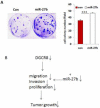Silencing the double-stranded RNA binding protein DGCR8 inhibits ovarian cancer cell proliferation, migration, and invasion
- PMID: 25823356
- PMCID: PMC3984613
- DOI: 10.1007/s11095-013-1219-9
Silencing the double-stranded RNA binding protein DGCR8 inhibits ovarian cancer cell proliferation, migration, and invasion
Abstract
Purpose: To evaluate the role of DiGeorge Critical Region 8 (DGCR8), a key component of miRNA biogenesis pathway in ovarian cancer.
Methods: The expression of DGCR8 in ovarian cancer was detected by immunostaining and DGCR8 knockdown in ovarian cancer cells was achieved using lentiviral shRNA. Differential expression of miRNAs was determined using Nanostring miRNA arrays and validated by real-time RT-PCR.
Results: DGCR8 was highly expressed in ovarian cancer. Knockdown of DGCR8 expression inhibits cell proliferation, migration, and invasion, as well as sensitizes cells to apoptosis induced by the chemotherapeutic drug cisplatin. Cellular survival pathways including ERK1/2 mitogen-activated protein kinase and phosphatidylinositol 3-kinase/AKT were attenuated in DGCR8 knockdown cells. DGCR8 knockdown results in dysregulated miRNA gene expression. miR-27b was identified as the most highly down-regulated miRNA in DGCR8 knockdown cells and promoted cell proliferation in ovarian cancer cells.
Conclusions: DGCR8 functions as an oncogene in ovarian cancer, which is in part mediated by miR-27b.
Figures







Similar articles
-
MiR-31 regulates the cisplatin resistance by targeting Src in gallbladder cancer.Oncotarget. 2016 Dec 13;7(50):83060-83070. doi: 10.18632/oncotarget.13067. Oncotarget. 2016. PMID: 27825112 Free PMC article.
-
Knockdown of Eag1 Expression by RNA Interference Increases Chemosensitivity to Cisplatin in Ovarian Cancer Cells.Reprod Sci. 2015 Dec;22(12):1618-26. doi: 10.1177/1933719115590665. Epub 2015 Jun 15. Reprod Sci. 2015. PMID: 26079730
-
Knockdown of eIF4E suppresses cell proliferation, invasion and enhances cisplatin cytotoxicity in human ovarian cancer cells.Int J Oncol. 2015 Dec;47(6):2217-25. doi: 10.3892/ijo.2015.3201. Epub 2015 Oct 13. Int J Oncol. 2015. PMID: 26498997
-
Differential role of microRNAs in prognosis, diagnosis, and therapy of ovarian cancer.Biomed Pharmacother. 2016 Dec;84:592-600. doi: 10.1016/j.biopha.2016.09.087. Epub 2016 Sep 30. Biomed Pharmacother. 2016. PMID: 27694003 Review.
-
SiRNA and epigenetic aberrations in ovarian cancer.J Cancer Res Ther. 2016 Apr-Jun;12(2):498-508. doi: 10.4103/0973-1482.153661. J Cancer Res Ther. 2016. PMID: 27461600 Review.
Cited by
-
Lentiviral Vector Mediated Claudin1 Silencing Inhibits Epithelial to Mesenchymal Transition in Breast Cancer Cells.Viruses. 2015 Jun 10;7(6):2965-79. doi: 10.3390/v7062755. Viruses. 2015. PMID: 26067567 Free PMC article.
-
MicroRNA-27b up-regulated by human papillomavirus 16 E7 promotes proliferation and suppresses apoptosis by targeting polo-like kinase2 in cervical cancer.Oncotarget. 2016 Apr 12;7(15):19666-79. doi: 10.18632/oncotarget.7531. Oncotarget. 2016. PMID: 26910911 Free PMC article.
-
Modulation of chemoresponsiveness to platinum-based agents by microRNAs in cancer.Am J Cancer Res. 2017 Sep 1;7(9):1769-1778. eCollection 2017. Am J Cancer Res. 2017. PMID: 28979802 Free PMC article. Review.
-
MicroRNA biogenesis pathways in cancer.Nat Rev Cancer. 2015 Jun;15(6):321-33. doi: 10.1038/nrc3932. Nat Rev Cancer. 2015. PMID: 25998712 Free PMC article. Review.
-
microRNAs Biogenesis, Functions and Role in Tumor Angiogenesis.Front Oncol. 2020 Nov 27;10:581007. doi: 10.3389/fonc.2020.581007. eCollection 2020. Front Oncol. 2020. PMID: 33330058 Free PMC article. Review.
References
-
- Gregory RI, Yan KP, Amuthan G, Chendrimada T, Doratotaj B, Cooch N, Shiekhattar R. Nature. 2004;432:235–240. - PubMed
-
- Landthaler M, Yalcin A, Tuschl T. Curr Biol. 2004;14:2162–2167. - PubMed
-
- Han L, Zhang A, Zhou X, Xu P, Wang GX, Pu PY, Kang CS. Int J Oncol. 2010;37:299–305. - PubMed
-
- Sand M, Gambichler T, Skrygan M, Sand D, Scola N, Altmeyer P, Bechara FG. Cancer Invest. 2010;28:649–653. - PubMed
Publication types
MeSH terms
Substances
Grants and funding
LinkOut - more resources
Full Text Sources
Other Literature Sources
Medical
Miscellaneous

